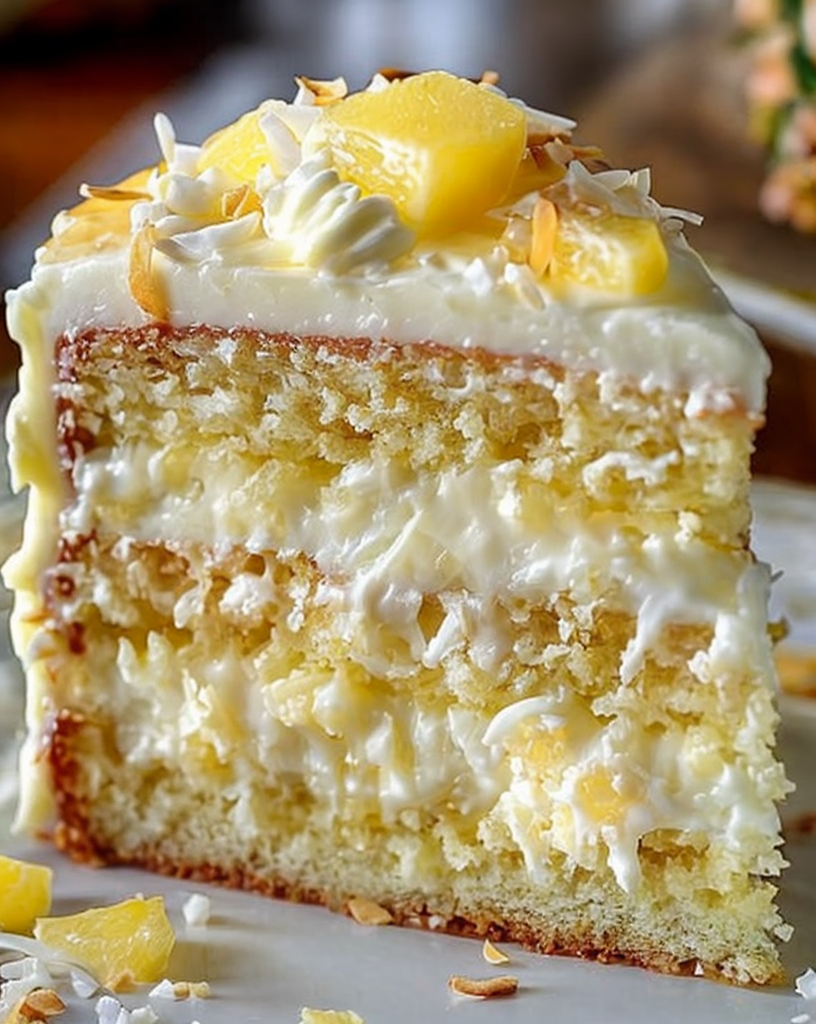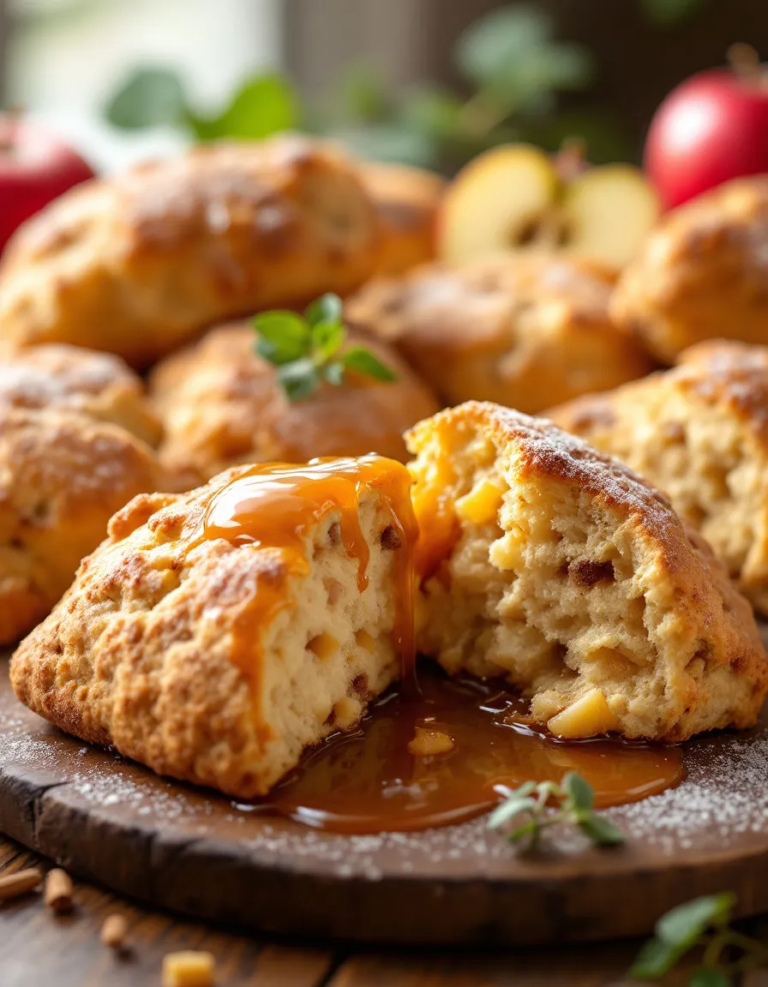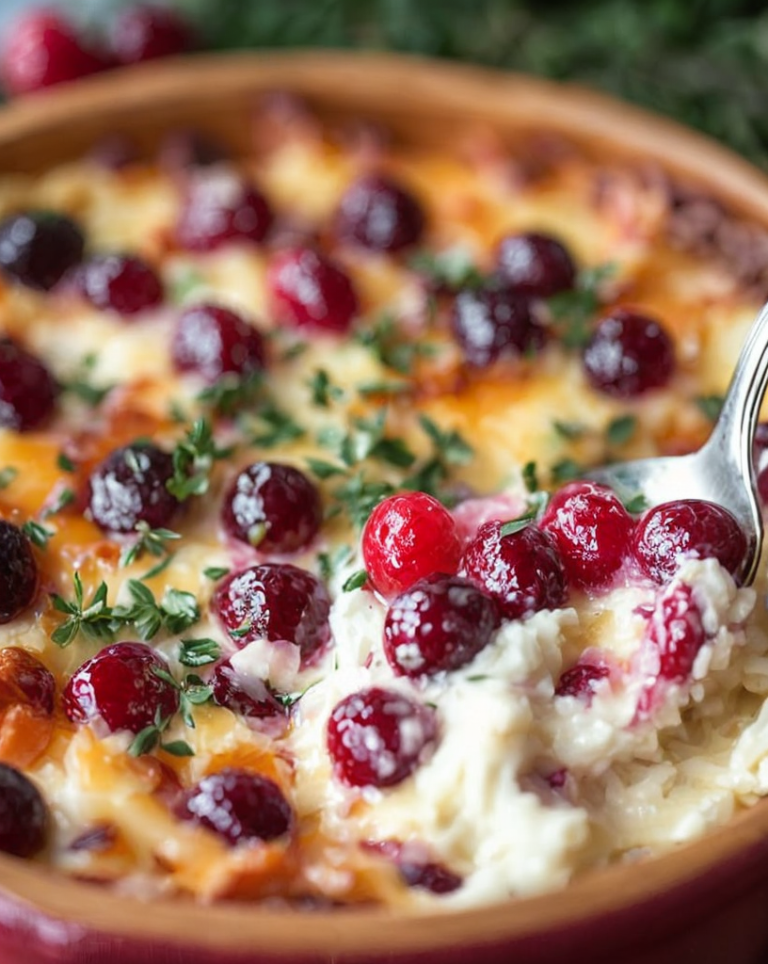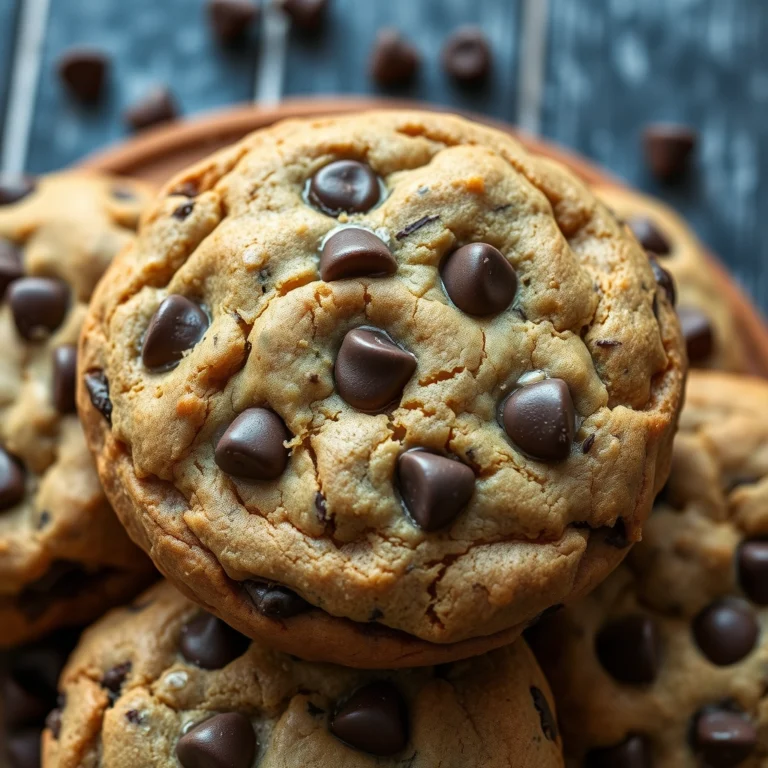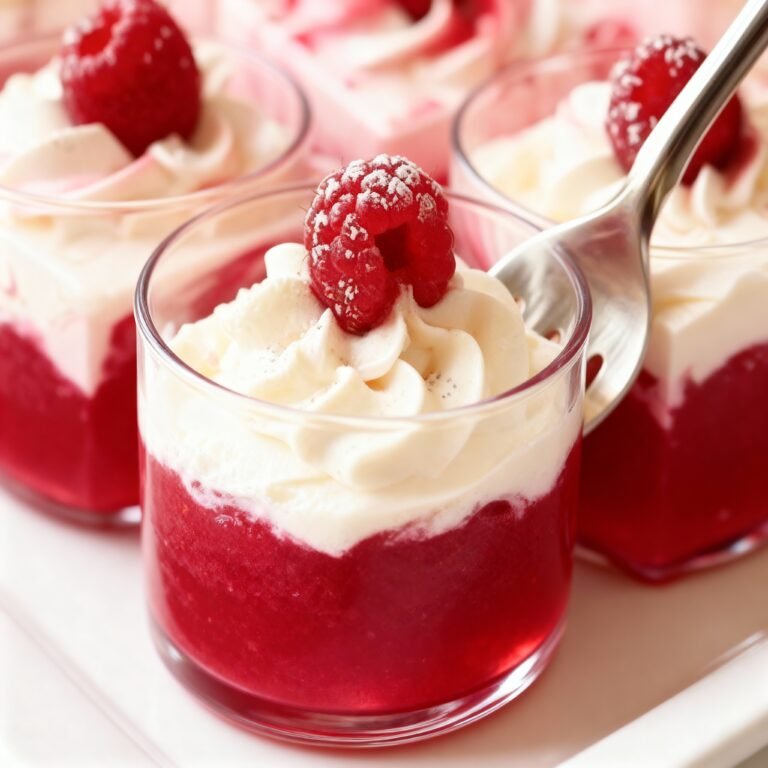Ultimate Hawaiian Pineapple Coconut Dream Cake: Easy and Family Favorite
Hawaiian Pineapple Coconut Dream Cake: A Tropical Delight
Indulge in the tropical essence of a Hawaiian Pineapple Coconut Dream Cake, a delicious blend of exotic flavors that embodies a dreamy vacation with every bite. This delightful cake brings together the sweetness of fresh pineapple and the creamy richness of coconut, promising a taste of paradise. Its vibrant flavor profile is perfectly complemented by a soft, moist texture that melts in your mouth, making it an ideal treat for any occasion.
The Hawaiian Pineapple Coconut Dream Cake is more than just a dessert; it is an experience that takes you to the sunny beaches and swaying palm trees of Hawaii. The cake’s inviting aroma, featuring hints of vanilla and toasted coconut, will fill your kitchen with a smell so delightful that you won’t be able to resist a slice before it’s even cooled. This cake is incredibly versatile, easily served as an afternoon snack, a celebratory dessert, or a sunny breakfast treat.
Quick Recipe Highlights
- Flavor Profile: This cake combines the tropical sweetness of pineapple with the creamy, nutty flavor of coconut, creating a harmonious blend that is both exotic and comforting.
- Texture: Enjoy a sponge-like cake with a moist, airy interior where each bite bursts with fresh pineapple chunks and flecks of shredded coconut.
- Aroma: The fragrance of this cake is dominated by the sweet scent of roasted coconut with subtle undertones of pineapple and vanilla.
- Visual Appeal: With its golden-brown crust and sprinkled coconut topping, this cake is unquestionably a feast for both the eyes and the palate.
- Skill Level Needed: This recipe is straightforward, making it perfect for bakers of any skill level, requiring only basic measuring and mixing techniques.
- Special Equipment: A standard cake pan and an electric mixer are the primary tools required, ensuring a hassle-free baking experience.
Recipe Overview
- Difficulty Level: The Hawaiian Pineapple Coconut Dream Cake is categorized as easy, given its simple steps and minimal ingredients. The forgiving nature of the recipe means a high likelihood of success for even novice bakers.
- Category: This versatile cake fits seamlessly into categories such as desserts and sweets, but can also serve as a delectable option for afternoon teas and brunches.
- Cuisine: Steeped in Hawaiian culinary traditions, this cake reflects the island’s love of fresh, bold ingredients, emphasizing the region’s tie to tropical flavors.
- Cost: The ingredients for this recipe are relatively inexpensive, particularly if you have basic baking essentials on hand, keeping overall costs low.
- Season: While this cake can be enjoyed year-round, its fresh and fruity taste makes it an especially fitting choice for spring and summer gatherings.
- Occasion: Perfect for family get-togethers, picnics, and birthday parties, this cake is highly adaptable for any joyful occasion.
Why You’ll Love This Recipe
The Hawaiian Pineapple Coconut Dream Cake offers an irresistible combination of taste and texture, captivating with its lush pineapple sweetness and light coconut nuances. Each bite delivers a satisfying balance between chewy pineapples and tender cake. Convenience is a hallmark of this recipe, requiring just over an hour from start to finish, most of which is unattended baking time. This makes it an excellent choice for busy cooks looking to deliver maximum flavor with minimal effort.
Nutritionally, this cake incorporates several key ingredients with beneficial properties. Pineapple is rich in vitamin C and manganese, contributing to immune health and metabolic function. Coconut adds dietary fiber and healthy fats, increasing satiety with fewer calories. These elements ensure a treat that’s gratifying not just in taste but also in its nutritive profile.
As a centerpiece, this cake adds a special touch to gatherings, encouraging social connections through its shared enjoyment. Its bright, tropical flavors invoke happiness and put a celebratory spin on any meal, making it a conversation starter and an instant crowd-pleaser.
Beyond its flavor and celebratory potential, the Hawaiian Pineapple Coconut Dream Cake is cost-effective and comprised of readily available ingredients. Affordable canned pineapple and coconut provide a luxurious taste without the need for extravagant purchases, ensuring accessibility for everyone who wishes to relish this Hawaiian-inspired delight.
Historical Background and Cultural Significance
Rooted in the heart of Hawaiian cuisine, the Hawaiian Pineapple Coconut Dream Cake reflects the islands’ vibrant agricultural bounty and multicultural influences. Pineapple, one of Hawaii’s largest exports since the 20th century, has become synonymous with the region and its culinary heritage. Introduced by early European explorers and later cultivated extensively by American businessmen like James Dole, the fruit transformed the cultural landscape and economy.
Coconut, another staple of tropical regions worldwide, combines with pineapple to create a flavor profile essential to Polynesian-inspired desserts. This pairing emphasizes not only the local agriculture but also the islanders’ knack for creating simple yet reinventive flavors. Throughout the decades, recipes like this cake have evolved from traditional Hawaiian puddings, continuously refined to suit contemporary tastes while preserving historical roots.
As the cake recipe traveled beyond island shores, it adapted to the palates and resources available in various regions. Today, variations abound, including vegan and gluten-free adaptations, ensuring widespread appeal without losing its quintessential Hawaiian essence. This evolution highlights the cultural adaptability and enduring international allure of Hawaiian culinary traditions.
Ingredient Deep Dive
Pineapple is the standout ingredient in this recipe, bringing a wealth of history and nutritional benefits. Originally native to South America, pineapple made its voyage to Hawaii where it thrived due to the warm climate and volcanic soil. Today, it’s a symbol of hospitality and an icon of Hawaiian culture. Nutritionally, pineapple is a powerhouse, loaded with antioxidants and digestive enzymes like bromelain, which aid digestion and help reduce inflammation.
For optimal flavor and texture, choose pineapples with uniformly glossy skin, free from soft spots or bruises. If using canned pineapple, look for varieties packed in their natural juice to avoid added sugars. Proper storage involves refrigerating fresh pineapple once cut, where it can last up to five days. Substitutions like using fresh pineapple chunks in place of canned ones, or pineapple sorbet as a topping, provide creative variations.
Coconut delivers subtle sweetness and a creamy texture. As a staple in tropical diets, its history intertwines with health benefits such as enhancing heart health through its healthy fats. Choosing high-quality, unsweetened shredded coconut is key to managing sweetness levels, while storing it in an airtight container extends shelf life. For those wanting to avoid coconut, almonds can provide a similar nutty flavor and texture, though they’ll alter the traditional profile slightly.
Common Mistakes to Avoid
- Overmixing the batter can lead to a dense cake. Stir just until the ingredients are combined for optimal lightness.
- Using overly ripe pineapples can result in excess moisture, affecting the cake’s structure. Choose firm ripe pineapples for the best result.
- Failing to thoroughly grease the baking pan may cause the cake to stick. Use both butter and parchment paper for easy release.
- Skipping the room temperature stage for wet ingredients can hinder even baking, so ensure they are well acclimated.
- Ignoring the importance of coconut toasting enhances flavor. Lightly toast to bring out its natural oils and aroma.
- Measuring flour inaccurately, either over or under-packing results in texture issues. Use the spoon and level method for precision.
- Opening the oven door frequently can cause the cake to sink. Only peek once or twice towards the end of baking.
- Not allowing the cake to cool completely before cutting can lead to crumbling and uneven slices.
Essential Techniques
One essential technique when making the Hawaiian Pineapple Coconut Dream Cake is mastering the art of incorporating ingredients gently. Overmixing can result in a tough final product, so remember that each stroke should fold rather than beat. Watching for visual cues, like when the dry ingredients have just dissolved, indicates the perfect stopping point.
Toasting coconut flakes elevates the cake’s flavor profile. This simple yet crucial process maximizes oil extraction, yielding deeper aroma and taste. Place coconut flakes in a dry pan on medium heat and stir continuously until they achieve a golden-brown hue. Staying attentive is key, as coconut can burn quickly.
Even cake layers are achieved using the leveling technique. After pouring the batter into the pan, smooth the surface with a spatula to prevent air bubbles from causing imbalance. Proper leveling ensures an aesthetically pleasing rise and uniform texture in every slice.
Pro Tips for Perfect Hawaiian Pineapple Coconut Dream Cake
Consider adding a splash of vanilla extract to enhance the sweetness and add complexity to the cake’s flavor profile. Another useful tip is to allow the cake to sit overnight in the refrigerator, wrapped in plastic. This resting period enhances texture and flavor, making the cake even more delectable.
If using fresh pineapple, strain the juice well before incorporating it into the batter to avoid excess moisture. Likewise, using full-fat coconut milk not only amplifies the coconut flavor but also contributes to a luscious, rich texture.
When baking, be sure to have every ingredient at room temperature, particularly eggs and butter. This simple detail helps the batter emulsify properly, ensuring an even rise and smooth crumb.
Experiment with a sprinkled topping of raw sugar before baking for an added crunch and appealingly rustic presentation. Toasted coconut can sprinkle the finished cake for extra aroma and visual appeal.
Variations and Adaptations
Regional variations of the Hawaiian Pineapple Coconut Dream Cake include adding native island ingredients such as macadamia nuts or papaya for a richer tropical finish. Macadamia nuts introduce a satisfying crunch that complements the cake’s softness.
For a seasonal adaptation, replace fresh pineapple with mango during summer months. The juicy mango pieces provide a nuanced sweetness and vibrant color contrast, highlighting a different facet of tropical fruit enjoyment.
Adapt the recipe for specific dietary requirements by substituting ingredients. A gluten-free version can easily be achieved using almond flour or a gluten-free baking mix. For a dairy-free twist, coconut yogurt can replace any cream-based frosting, enhancing the coconut theme.
To adjust flavor, incorporate a splash of rum or pineapple liqueur into the batter, adding a bold, mature flavor note that marries well with the tropical ingredients.
Modify the cake’s texture by adding elements such as finely shredded carrots or zucchini. These additions inject moisture and subtle flavor variations, bringing further depth to the delicious base.
For an elegant presentation, bake the cake in individual ramekins for personal servings. Top each with whipped coconut cream and a cherry for an attractive, single-serve dessert.
Serving and Presentation Guide
Perfect plating of the Hawaiian Pineapple Coconut Dream Cake can elevate its appeal exponentially. Serve it on a vibrant, contrasting plate to emphasize its luscious tones. Utilize a circular cookie cutter to create uniform, bite-sized servings perfect for parties or buffets.
Fresh, edible flowers, like hibiscus or orchids, can provide a striking garnish, evoking the natural beauty of Hawaii. A light dusting of powdered sugar or cocoa adds a final touch of elegance without overpowering flavors.
For traditional accompaniment, serve alongside a scoop of vanilla or coconut ice cream. This pairing emphasizes the cake’s tropical elements, providing a dessert that’s visually and sensorially seamless.
If opting for a modern twist, pair with a citrus-infused spritz of lime or yuzu sorbet on the side. This bright and tangy contrast will highlight the cake’s depth and invigorate the palate.
Consider portion control by slicing the cake into modest squares or small wedges, allowing easy accessibility and portioning for larger gatherings.
Temperature is critical; serve the cake either warm or completely cooled to highlight different textures. Warm slices have intensified aromas and a softer bite, while cooled servings allow flavors to meld beautifully.
Wine and Beverage Pairing
The best wine pairing for the Hawaiian Pineapple Coconut Dream Cake is a light, fruity dessert wine such as a Moscato or Riesling. These wines’ inherent sweetness complements the luscious pineapple and rich coconut without overwhelming the palate.
For those seeking non-alcoholic options, a chilled tropical fruit tea or pineapple-infused water provides refreshing acidity to balance the cake’s sweetness. Alternatively, a delicate jasmine tea evokes floral notes and pairs well with coconut nuances.
If coffee is preferred, opt for a light roast, cold-brewed coffee. Its mild bitterness and smooth texture harmonize with the cake’s sweet, tropical flavors without clashing.
Temperature considerations should include serving drinks slightly chilled to harmonize with the cake’s tropical profile. Cool, refreshing beverage temperatures add to the cake’s elegant presentation and enjoyment.
For serving suggestions, serve beverages in clear glassware to emphasize color and allow for visual appeal as beautiful as the cake itself. Consider incorporating pineapple or coconut garnishes into the drink presentation to mirror the cake’s ingredients.
Storage and Shelf Life
Proper storage ensures the Hawaiian Pineapple Coconut Dream Cake retains its delightful flavors and textures. Store the cake in an airtight container at room temperature for up to three days. This containment preserves moisture without encouraging spoilage.
When longer preservation is necessary, refrigerate the cake, ensuring it’s well wrapped to prevent air exposure. Cold storage can extend shelf life to five days, though flavor nuances may become mellowed with time.
Signs of spoilage include any change in color or odor; ensure regular inspection for freshness. If freezer storage is required, slice the cake and wrap each piece individually, then place them in a freezer-safe bag for ease of storage.
Reheating should be gentle to preserve texture; use a microwave at a low setting or let thaw completely before enjoying. Reheat by placing in a low-temperature oven, ensuring it remains moist.
Freezing guidelines emphasize wrapping fully cooled, uneaten slices immediately after serving to guarantee flavor preservation. Date all stored portions to track freshness and savor this delicious cake whenever the craving strikes.
Make Ahead Strategies
Advance preparation becomes a breeze with the Hawaiian Pineapple Coconut Dream Cake, letting you effortlessly manage your time while ensuring spectacular results. Establish a prep timeline, organizing tasks such as measuring and mixing ingredients a day ahead.
Between steps, cover the batter thoroughly, refrigerating it overnight if necessary. This extended resting period melds flavors, heightening both taste and texture. Assess the quality impact, noting if standing time augments richness.
Assembly tips include layering the batter evenly in the pan, avoiding unnecessary manipulation to preserve airiness. When reheating slices, gently warm in a low oven to restore initial freshness without jeopardizing the cake’s moist character.
Add fresh elements like whipped cream or toasted coconut just before serving to provide brightness and vigor in visually appealing form. This ensures an enticing final presentation that appears freshly made.
Scaling Instructions
Scaling the Hawaiian Pineapple Coconut Dream Cake according to guest count or desired servings is seamless. To halve the recipe, divide all ingredient measurements by two and adjust baking times accordingly—checking for doneness via skewer.
When doubling or tripling, ensure oven and pan capacity while maintaining proportional baking times. Watch for visual cues like a golden surface and clean toothpick test to determine readiness.
Equipment adjustments may include using a larger mixing bowl and additional pans where needed to handle increased volume effectively. Modify timing as essential to accommodate potential changes in density or thickness.
Consider storage amendments, utilizing airtight bags or containers in various sizes to store more significant quantities. Scale ingredient purchases meticulously, ensuring availability and limiting wastage for cost-effectiveness.
Nutritional Deep Dive
Delving into the nutritional layer of the Hawaiian Pineapple Coconut Dream Cake reveals a profile where ingredients align harmony and health. The cake features a balanced macronutrient ratio, providing carbohydrates, proteins, and fats through its components.
Micronutrient analysis highlights vitamin C and manganese from pineapple, supporting immune function and bone health. Meanwhile, coconut offers medium-chain triglycerides beneficial for cognitive and heart health.
Health benefits arise from the combination of fibers, healthy fats, and antioxidants, assisting in maintaining overall well-being alongside treating tastebuds. Manage dietary considerations like portion control to prevent potential caloric surplus.
Each slice presents a balanced portion, allocating nutritional elements sufficient for satisfaction without excess. This encourages conscious indulgence through mindful consumption of a nourishing dessert.
For weight management, remember to savor the cake in moderation, integrating it within active, varied dietary patterns. This celebration of flavor and nutrition becomes supplementary to a holistic lifestyle, coupling joy and health.
Dietary Adaptations
Adapting the Hawaiian Pineapple Coconut Dream Cake for different diets enhances versatility while retaining flavor integrity. A gluten-free version swaps traditional flour with alternatives like almond or coconut flour, offering a similar texture with reduced gluten content.
Dairy-free modifications can replace butter with coconut oil, keeping within the coconut theme and ensuring a richer flavor. Vegan enthusiasts may substitute eggs with flaxseed or chia seed mixtures, maintaining structural integrity while avoiding animal products.
Low-carb adaptations focus on reducing sugar content, using sugar substitutes like erythritol or stevia to preserve sweetness without carbohydrates. Similarly, Keto versions explore coconut flour and sugar-free baking additions to align with ketogenic guidelines.
Paleo adaptations retain a focus on natural ingredients, employing grain-free flours and natural sweeteners like honey or maple syrup. Low-FODMAP adherents may elect to remove high FODMAP fruits like pineapple, otherwise ensuring balance with compatible substitutes.
The Recipe
Hawaiian Pineapple Coconut Dream Cake
Serves: 8
Prep Time: 20 mins
Cook Time: 45 mins
Total Time: 65 mins
Kitchen Equipment Needed
- Electric mixer
- Mixing bowls
- Cake pan
- Spatula
- Measuring cups and spoons
- Cooling rack
Ingredients
- 1 cup all-purpose flour
- 1 cup granulated sugar
- 1/2 cup unsalted butter, softened
- 3 large eggs, at room temperature
- 1 tsp vanilla extract
- 1 cup crushed pineapple in natural juice, drained
- 1 cup sweetened shredded coconut
- 1/2 cup coconut milk
- 1 tsp baking powder
- 1/4 tsp salt
Directions
- Preheat your oven to 350°F (175°C). Grease a cake pan generously with butter or nonstick cooking spray.
- In a bowl, whisk together flour, baking powder, and salt. Set aside.
- In a separate large bowl, cream together butter and sugar until light and fluffy. Add eggs one at a time, beating well after each addition. Stir in vanilla extract.
- Incorporate dry ingredients alternately with coconut milk into the wet mixture, beginning and ending with the flour mixture. Mix until just combined.
- Gently fold in pineapple and shredded coconut until evenly distributed.
- Pour batter into the prepared cake pan, smoothing the top with a spatula.
- Bake in the preheated oven for 40-45 minutes, or until a toothpick inserted into the center of the cake comes out clean.
- Allow to cool in the pan for 10 minutes, then transfer to a cooling rack.
Recipe Notes
- Ensure all ingredients are at room temperature for even mixing and baking.
- Coconut milk can be substituted with regular milk or almond milk for variation.
- For added flair, sprinkle toasted coconut over the cake before serving.
Troubleshooting Guide
Addressing texture issues in the Hawaiian Pineapple Coconut Dream Cake involves careful observation during ingredient mixing. A dense cake indicates overmixing or improper leavening, remedied by gentler incorporation of dry ingredients and verifying baking powder effectiveness.
If flavor balance feels off, reassess pineapple and coconut quantities. Too much pineapple can overwhelm batter consistency, while too little coconut muddles flavor complexity. Ensure adherence to recipe measurements for optimal results.
Temperature challenges manifest in uneven baking. Investing in an oven thermometer guarantees accurate heat, and rotating the cake halfway through baking achieves uniformity. Managing equipment to match recipe directives avoids such pitfalls.
Ingredient substitutions influence outcomes significantly. Employ precise replacements like dairy alternatives only when confident of similar chemical properties, and rely on trusted recipes or adaptions for guidance.
Addressing timing concerns entails accurate measurement and attentiveness from start to finish. Setting timers and verifying doneness through sight and smell allows tracking without risking under or overbaking.
Recipe Success Stories
This recipe’s success extends to the diverse community that has embraced its tropical charm. Readers in Hawaii, California, and beyond have lauded its authenticity, celebrating the cake at birthdays, potlucks, and family dinners.
Variations featuring local ingredients like papaya or kiwi highlight creative endeavors with delightful results. Bakers share enthusiasm for the ease of assembling, compared to incredibly satisfied review results and photographs.
Community adaptations have included gluten-free renditions, vegan alternatives, and scaled-down batches for intimate settings. These dialogues provide invaluable insight, encouragement, and building confidence among new participants.
Photography tips from readers enrich visual storytelling, showcasing techniques like natural lighting, enticing close-ups, and contrasting backgrounds to emphasize the cake’s vibrancy.
Frequently Asked Questions
Q: Can I use fresh pineapple instead of canned?
A: Yes, fresh pineapple can enrich flavor but ensure proper draining. Use firm, ripe chunks to avoid moisture imbalance that compromises texture.
Q: How do I ensure my cake stays moist?
A: Measure ingredients accurately and don’t overbake. Utilizing quality coconut milk, as directed, enhances moisture retention and provides a creamy texture.
Q: Can I freeze slices for later consumption?
A: Absolutely! Slice and individually wrap each piece before placing them in an airtight container or freezer bag. Thaw overnight in the fridge for best results.
Q: What adjustments are needed for high-altitude baking?
A: At high altitudes, reduce sugar slightly and bake at slightly higher temperatures. Monitor doneness closely, as baking times may vary.
Q: Can this recipe be doubled for a large group?
A: Yes, doubling the ingredients is straightforward; utilize a larger pan and extend baking time. Check doneness based on visual cues and toothpick tests.
Q: How do I make the cake nut-free?
A: The base recipe is already nut-free unless substitutions, like adding macadamia nuts, are made. Maintain ingredient specifications for nut-free assurance.
Q: What’s the best way to serve the cake warm?
A: Warm individual slices in the oven briefly before serving. Pair with chilled accompaniments like ice cream for temperature contrast that enhances enjoyment.
Q: Can alternative flours like coconut flour be used?
A: While coconut flour can be substituted, it affects moisture and density, necessitating adjustments to liquids and eggs. Follow specialized recipes for best success.
Q: Is there a vegan version of this cake?
A: Certainly, substitute eggs with flax or chia eggs and use coconut oil instead of butter to maintain richness while adhering to vegan guidelines.
Q: What if my cake turns out too dry?
A: Verify precise measurements and sufficient inclusion of moistening ingredients like coconut milk. Adjust baking time appropriately, avoiding prolonged periods to prevent dryness.
Additional Resources
Explore related recipes like tropical fruit tarts or coconut macaroons for sweet alternatives rooted in the same flavor family. Access technique guides on cake baking for deeper knowledge into successful outcomes.
Ingredient information surrounding tropical fruits and coconut widens understanding and appreciation for quality selection. Equipment recommendations include affordable mixer models and effective non-stick baking trays to aid recipe execution.
Seasonal variations highlight fresh kiwi during summer or spiced ginger in winter, expanding ways to enjoy the cake year-round. Utilize these articles and guides to enrich culinary skills and home-baking ambition.
Join the Conversation
Share your Hawaiian Pineapple Coconut Dream Cake experiences on social media, hashtagging to spread the joy and flavor. Engage with a bustling community of bakers eager to connect and exchange ideas.
Highlight photography creativity by implementing tips on lighting and composition, capturing the cake’s luscious appeal for both personal and audience enjoyment. Manage recipe reviews to gauge success, implementing valuable insights for future endeavors.
Encourage community engagement through recipe variation trials, sharing feedback to improve and expand upcoming baking projects. Collaboration within recipe variations inspires viral ideas, further enriching this cake’s delightful legacy.

